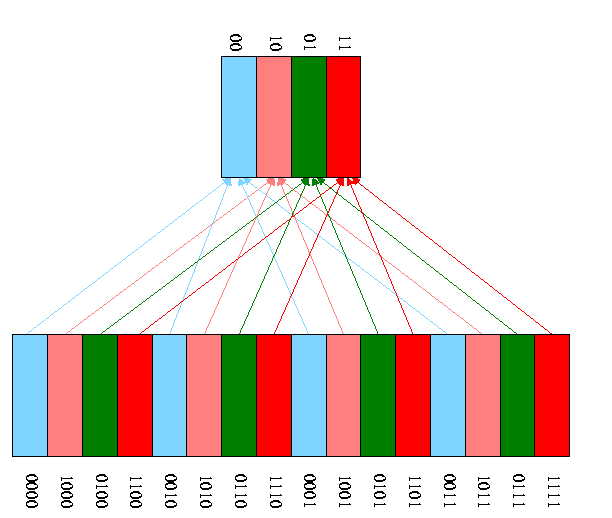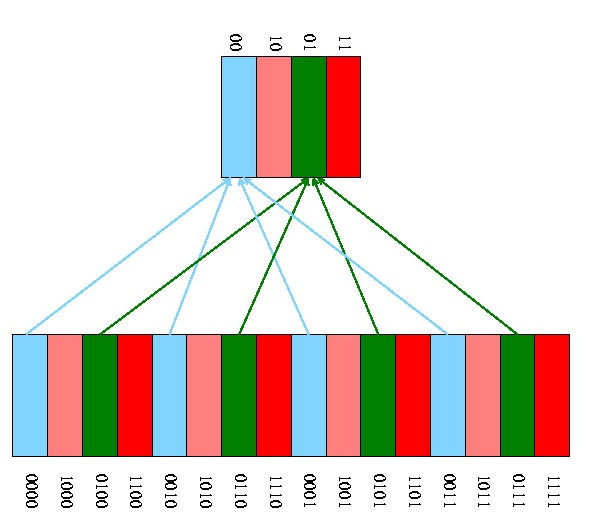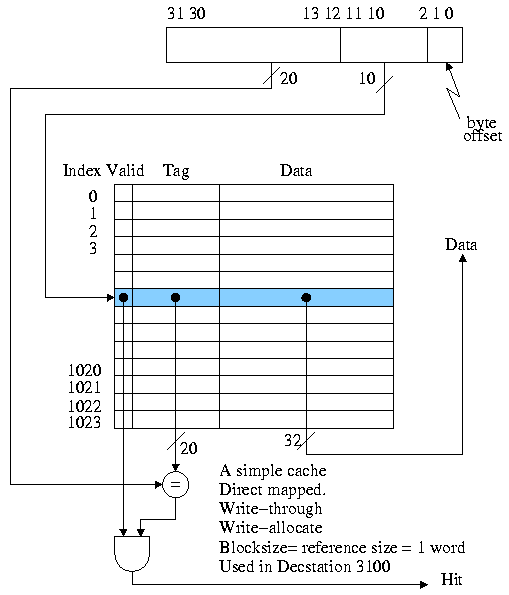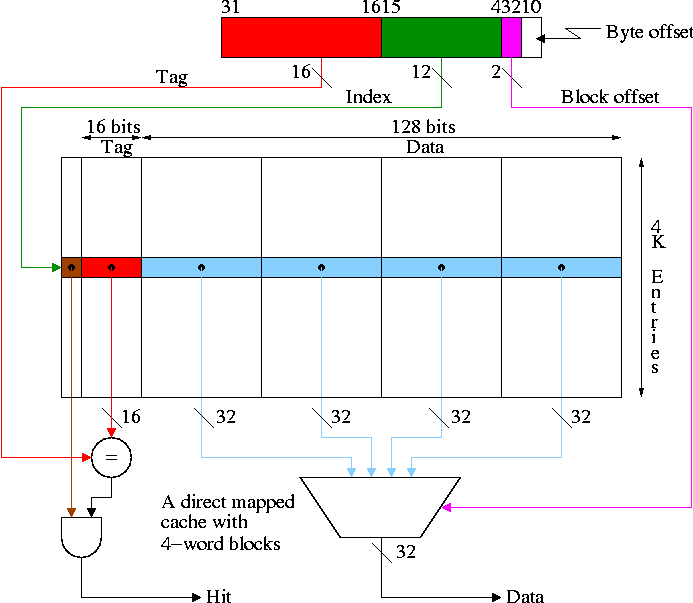======== START LECTURE #20
========


Note:
Lab3 is assigned and due in 3 weeks.
End of Note
7.2: The Basics of Caches
We start with a very simple cache organization. One that was used on
the Decstation 3100, a 1980s workstation.
-
Assume all referencess are for one word (not too bad).
-
Assume cache blocks are one word.
-
This does not take advantage of spatial locality so is not
done in modern machines.
-
We will drop this assumption soon.
-
Assume each memory block can only go in one specific cache block
-
This is called a Direct Mapped organization.
-
The location of the memory block in the cache (i.e., the block
number in the cache) is the memory block number modulo the
number of blocks in the cache.
-
For example, if the cache contains 100 blocks, then memory
block 34452 is stored in cache block 52. Memory block 352 is
also stored in cache block 52 (but not at the same time, of
course).
-
In real systems the number of blocks in the cache is a power
of 2 so taking modulo is just extracting low order bits.
-
Example: if the cache has 16 blocks, the location of a block in
the cache is the low order 4 bits of block number.
-
On the right is a pictorial example for a cache with only 4 blocks
and a memory with only 16 blocks.
-
How can we tell if a memory block is in the cache?
-
We know where it will be if it is there at all
(memory block number mod number of blocks in the cache).
-
But many memory blocks are assigned to that same cache block.
For example, in the diagram above all the green
blocks in memory are assigned to the one green block in the cache.
-
So we need the ``rest'' of the address (i.e., the part lost
when we reduced the block number modulo the size of the cache)
to see if the block in the cache is the memory block of
interest.
-
The cache stores the rest of the address, called the
tag and we check the tag when looking for a block
-
Also stored is a valid bit per cache block so that we
can tell if there is a memory block stored in this cache
block.
For example, when the system is powered on, all the cache
blocks are invalid.
| Address(10) | Address(2) | hit/miss | block# |
|---|
| 22 | 10110 | miss | 110 |
| 26 | 11010 | miss | 010 |
| 22 | 10110 | hit | 110 |
| 26 | 11010 | hit | 010 |
| 16 | 10000 | miss | 000 |
| 3 | 00011 | miss | 011 |
| 16 | 10000 | hit | 000 |
| 18 | 10010 | miss | 010 |
Example on pp. 547-8.
- Tiny 8 word direct mapped cache with block size one word and all
references are for a word.
- In the table on the right, all the addresses are word addresses. For
example the reference to 3 means the reference to word 3 (which
includes bytes 12, 13, 14, and 15).
- If reference experience a miss and the cache block is valid, the
current contents of the cache block is discarded (in this example
only) and the new reference takes its place.
- Do this example on the board showing the address store in the
cache at all times

The basic circuitry for this simple cache to determine hit or miss
and to return the data is quite easy. We are showing a 1024 word
(= 4KB) direct mapped cache with block size = reference size = 1 word.
Calculate on the board the total number of bits in this cache.
Homework:
7.1 7.2 7.3
Processing a read for this simple cache.
-
The action required for a hit is obvious, namely return the data
found to the processor.
-
For a miss, the action best action is fairly clear, but requires
some thought.
- Clearly we must go to central memory to fetch the requested
data since it is not available in the cache.
- The only question is should we place this new data in the
cache replacing the old, or should we maintain the old.
- But it is clear that we want to store the new data instead of
the old.Why?
Ans: Temporal Locality
- What do we do with the old data, can we just toss it or do we
need to write it back to central memory.
Ans: It depends! We will see shortly that the action needed on a
read miss, depends on our action for write hits.
Skip the section ``handling cache misses'' as it discusses the
multicycle and pipelined implementations of chapter 6, which we
skipped. For our single cycle processor implementation we just need
to note a few points.
- The instruction and data memory are replaced with caches.
- On cache misses one needs to fetch/store the desired
datum or instruction from/to central memory.
- This is very slow and hence our cycle time must be very
long.
- A major reason why the single cycle implementation is
not used in practice.
Processing a write for our simple cache (direct mapped with block
size = reference size = 1 word).
-
We have 4 possibilities:
-
For a write hit we must choose between
Write through and Write back.
-
Write through: Write the data to memory as well as to the cache.
-
Write back: Don't write to memory now, do it
later when this cache block is evicted.
-
Thus the write hit policy effects our read miss policy as
mentioned just above.
-
For a write miss we must choose between
write-allocate and
write-no-allocate
(also called
store-allocate and
store-no-allocate).
-
Write-allocate:
-
Write the new data into the cache.
-
If the cache is write through, discard the old data
(since it is in memory) and write the new data to memory.
-
If the cache is write back, the old data must now be
written back to memory, but the new data is not
written to memory.
-
Write-no-allocate:
-
Leave the cache alone and just write central memory
with the new data.
-
Not as popular since temporal locality favors
write-allocate.
-
The simplist is write-through, write-allocate.
-
We are still assuming block size = reference size = 1 word and
direct mapped.
-
For any write (hit or miss) do the following:
-
Index the cache using the correct LOBs (i.e., not the very
lowest order bits as these give the byte offset).
-
Write the data and the tag into the cache.
- For a hit, we are overwriting the tag with itself.
- For a miss, we are performing a write allocate and,
since the cache is write-through, memory is guaranteed to
be correct, we can simply overwrite the current entry.
-
Set Valid to true.
-
Send request to main memory.
-
Poor performance
-
For the GCC benchmark 11% of the operations are stores.
-
If we assume an infinite speed central memory (i.e., a
zero miss penalty) or a zero miss rate, the CPI is 1.2 for
some reasonable estimate of instruction speeds.
-
If we assume a 10 cycle store penalty (conservative) since
we have to write main memory (recall we are using a
write-through cache), then the
CPI becomes 1.2 + 10 * 11% = 2.5, which is
half speed.
Improvement: Use a write buffer
- Hold a few (four is common) writes at the processor while they are
being processed at memory.
- As soon as the word is written into the write buffer, the
instruction is considered complete and the next instruction can
begin.
- Hence the write penalty is eliminated as long as the word can be
written into the write buffer.
- Must stall (i.e., incur a write penalty) if the write buffer is
full. This occurs if a bunch of writes occur in a short period.
- If the rate of writes is greater than the rate at which memory can
handle writes, you must stall eventually. The purpose of a
write-buffer (indeed of buffers in general) is to handle short bursts.
- The Decstation 3100 (which employed the simple cache structure
just described) had a 4-word write buffer.
Unified vs split I and D (instruction and data) caches
- Given a fixed total size (in bytes) for caches, is it better to have two
caches, one for instructions and one for data; or is it better to have
a single ``unified'' cache?
-
Unified is better because it automatically performs ``load
balancing''. If the current program needs more data references
than instruction references, the cache will accommodate.
Similarly if more instruction references are needed.
-
Split is better because it can do two references at once (one
instruction reference and one data reference).
-
The winner is ...
split I and D.
-
But unified has the better (i.e. higher) hit ratio.
-
So hit ratio is not the ultimate measure of good cache
performance.

Improvement: Blocksize > Wordsize
-
The current setup does not take any advantage of spatial locality.
The idea of having a multiword blocksizes is to bring in words near
the referenced word since, by spatial locality, they are likely to
be referenced in the near future.
-
The figure below shows a 64KB direct mapped cache with 4-word
blocks.
-
What addresses in memory are in the block and where in the cache
do they go?
- The memory block number =
the word address / number of words per block =
the byte address / number of bytes per block
- The cache block number =
the memory block number modulo the number of blocks in the cache
- The block offset =
the word address modulo the number of words per block
- The tag =
the word addres / the number of words in the cache =
the byte address / the number of bytes in the cache
- Show from the diagram how this gives the red portion for the
tag and the green portion for the index or cache block number.
- Consider the cache shown in the diagram above and a reference to
word 17001.
- 17003 / 4 gives 4250 with a remainder of 3 .
- So the memory block number is 4250 and the block offset is 3.
- 4K=4096 and 4250 / 4096 gives 1 with a remainder of 154.
- So the cache block number is 154.
- Putting this together a reference to word 17003 is a reference
to the third word of the cache block with index 154
- The tag is 17003 / (4K * 4) = 1
-
Cachesize = Blocksize * #Entries. For the diagram above this is 64KB.
-
Calculate the total number of bits in this cache and in one
with one word blocks but still 64KB of data.
-
If the references are strictly sequential the pictured cache has 75% hits;
the simplier cache with one word blocks has no
hits.
-
How do we process read/write hits/misses?
-
Read hit: As before, return the data found to the processor.
-
Read miss: As before, due to locality we discard (or write
back) the old line and fetch the new line.
-
Write hit: As before, write the word in the cache (and perhaps
write memory as well).
-
Write miss: A new consideration arises. As before we might or
might not decide to replace the current line with the
referenced line. The new consideration is that if we decide
to replace the line (i.e., if we are implementing
store-allocate), we must remember that we only have a new
word and the unit of cache transfer is a
multiword line.
-
The simplest idea is to fetch the entire old line and
overwrite the new word. This is called
write-fetch and is something you wouldn't
even consider with blocksize = reference size = 1 word.
-
Why fetch the whole line including the word you are going
to overwrite?
Ans. The memory subsystem probably can't fetch just words
1,2, and 4 of the line.
-
Why might we want store-allocate and
write-no-fetch?
-
Ans: Because a common case is storing consecutive words:
With store-no-allocate all are misses and with
write-fetch, each store fetches the line to
overwrite another part of it.
-
To implement store-allocate-no-write-fetch (SANF), we need
to keep a valid bit per word.
Homework:
7.7 7.8 7.9
Why not make blocksize enormous? For example, why not have the cache
be one huge block.
-
NOT all access are sequential.
-
With too few blocks misses go up again.





